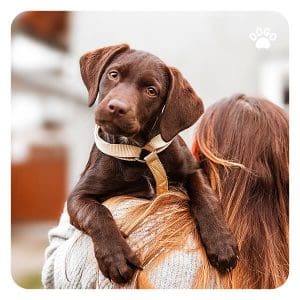
In this category, you can compare dogs to people. First, ask yourself, are there ONLY confident and brave people in the world? Of course not! As many as there are people in the world, there are as many different characters. You, your mom, your friend, or a lady at the store – you may be similar, but not the same. Everyone has different life experiences that shape their personality. Some people approach life fearfully, while others are not afraid of almost anything! The same applies to dogs. Each pet is a separate individual with unique personality traits.
What Can Influence a Puppy’s Character?
1. Parental Genes
The primary traits that dogs acquire from their parents shape their personalities and temperament. They can also significantly impact a dog’s ability to cope with new and stressful situations. It’s important to remember that each puppy is an individual and may have unique needs and challenges to overcome in order to become a confident and happy dog. However, this is only the basis of a dog’s self-esteem, and many more factors influence it.
2. Incorrect Socialisation

The puppy learns to talk with other dogs. Through playing with their siblings, they begin to analyze and understand the body language of other dogs. The mother ensures that she teaches the pup initial discipline. She introduces specific rules and regulations, teaches humility and consistency. Puppies should be with her at least until 8 weeks of age. Taken away too soon, it may suffer from severe communication deficiencies. It increases the chances of timidity towards other dogs and animals.
If a puppy is taken away from their mother and littermates too early, they may miss out on these important lessons and socialization opportunities. This can result in communication deficiencies and a greater likelihood of fearfulness and anxiety around other dogs and animals. It’s important to give puppies plenty of time to learn and grow in a safe and nurturing environment.
3. Incorrect Habituation
Habituation is the process of familiarizing a dog with different objects, sounds, or situations. Very often, something unknown triggers fear and uncertainty in a dog. That’s why it’s a good idea to familiarize the puppy with their new surroundings to avoid unnecessary stress.
The breeder is responsible for initial habituation. His task is to make the dog used to potentially stressful stimuli, also in terms of adoption. Is the breeder able to familiarize the puppy with all the objects, sounds, and situations in the world? Of course not! But suppose he familiarizes the puppy with at least a few. In that case, he will show them strategies for dealing with new and unfamiliar situations. It will help your dog gain some confidence and make them able to handle stressful circumstances in the future much better.
While breeders can help with initial habituation, it’s also important for new pet parents to continue this process once the puppy arrives in their new home. This can include gradually introducing them to new people, animals, and environments in a safe and controlled manner. By helping the puppy develop coping strategies for new and unfamiliar situations, you can help them build confidence and resilience for the future.
4. Unpleasant Experiences
Can a 2-4-month-old puppy have any experiences that affect their behavior? Definitely yes!
Experiences can be both positive and negative. Well-conducted socialization and habituation are valuable experiences that make a dog psychologically ready for further life. However, not every puppy is so lucky! There are unwanted litters that are separated from their mother and abandoned. They don’t receive proper care – they have to cope on their own. There are also puppies that, from the moment they are born, experience aggression and violence. They live in constant fear. No wonder they are withdrawn and fearful.
5. Fear Periods

During the fear period, the pooch remembers their experiences quite strongly. It has a significant impact on their later behavior. If the dog was heavily frightened during this period, they can develop a severe trauma or phobia. It is sufficient, for example, that another dog attacks them, so there is a high chance of trauma.
The same thing can happen with any object. For example, if your pooch is frightened by a whistling kettle, a falling broom, or a moving car, they might develop a fear of these objects in adulthood.
Two fear periods fall into the puppy stage:
1 fear period (between 8 and 10 weeks of age) – this is the time when the pooch should not be separated from their mother. It is she who gives them the greatest sense of security and support in crises. Separating a pup from their mother at this time can result in separation anxiety and other serious behavioral problems.
2 fear period (between 17 and 21 weeks of age) – at this stage, dogs have usually already left the kennel. The new parent is responsible for their further development, socialization, and habituation. At this time, puppies are very often distanced and cautious. The new pet parent needs to be patient and understanding.
6. Adaptation Time in a New Home
Leaving a kennel is a huge event for a puppy. They have just lost their asylum – the place where they felt safe and comfortable. They find themselves in a different house, with unknown people, new smells, sounds, objects, etc. Everything is strange, often frightening. The change of environment is associated with stress. When your four-legged friend gets used to the new situation, they may be withdrawn and scared. You should understand it and support them.
How to Eliminate Fear from Your Puppy’s Life?
- If you plan to adopt a puppy, find a professional and certified kennel.
Ensure that the puppies growing up in it have the right conditions for physical and mental development. The breeder should meet all the basic needs of the little ones.
- Before adopting a puppy, carefully ask about their parents.
Pay attention not only to health aspects but also to psychological ones. Their disposition towards life can give you a rough idea of the potential personality of your puppy.
- Make sure that the puppy has received initial socialization and habituation at the kennel.
Ask for a detailed description of these. Remember, the more you know about the puppy, the easier it will be for you to understand them.
- Do not adopt a puppy who is currently in a fear period.
It will reduce their stress level and minimize the chance of them becoming overly fearful in the future.
- If you have already adopted a puppy, give them time to get used to their new life.
Do not pet them too much, kiss or cuddle – respect their space. Arrange a private corner for your pet, where they can go in a stressful situation. Choose a quiet and peaceful place. Never disturb your dog while they are in it. Gradually familiarize your pooch with their new surroundings. Let them see and smell different objects. Praise and reward them when they explore and observe things. By doing so, you will show them support and encourage them to explore.
- If the time of acclimatization has passed and the puppy is still afraid of everything, try to increase their self-esteem and reduce their excitement level.

If you have no ideas for a sniffing activity, use the Dogo app. You will find plenty of inspiration.
Apart from fun, a great way to boost your dog’s self-esteem is by learning new skills. We highly recommend basic obedience commands and tricks. You can find them in the Dogo app, too.






